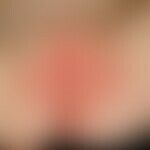Synonym(s)
DefinitionThis section has been translated automatically.
Acute, sub-acute or chronic dermatitis caused by contact with topical allergens (usually in type IV allergy, see allergy). In contrast to toxic contact dermatitis, allergic contact dermatitis requires sensitization. The extent of the skin inflammation depends on the degree of sensitization and the intensity (duration, occlusion, moisture, pressure, localization) of the allergen contact.
Rarely does an immediate type reaction (atopy patch test, type IV reaction to type I allergens) trigger an allergic contact allergy.
ClassificationThis section has been translated automatically.
A distinction must be made:
- Acute allergic contact dermatitis
- Chronic allergic contact dermatitis (caused by repetitive contact)
You might also be interested in
Occurrence/EpidemiologyThis section has been translated automatically.
The disease is one of the most common skin diseases in Germany. Prevalence for Germany/Europe: 5-27% (depending on method) of the total population (Uter W et al. 2018).
EtiopathogenesisThis section has been translated automatically.
ClinicThis section has been translated automatically.
24-48 hours after contact with the allergen, a usually blurred, clearly itchy, slightly elevated plaque forms initially at the contact site, later extending beyond the contact area, which is interspersed with tiny blisters or even nodules. Even after removing the contact allergen, the inflammatory reaction can intensify further(crescendo reaction). Severe contact allergic eczema is characterized by large blisters and, after they burst, by extensive erosions, oozing and crusting. Healing takes place with a rather coarse flaking of the skin. If the allergen is not known and there is repeated allergen contact, this leads to a chronic eczema pattern with initially local scattering phenomena; with strong sensitization, generalized dermatitic reactions can also occur. The picture of chronic contact allergic dermatitis differs significantly from the acute reaction. It now presents a more varied picture with flat, lichenified, scaly, gray-red plaques interspersed with erosions, scaly crusts and rhagades.
TherapyThis section has been translated automatically.
Avoid the triggering noxious agent. Testing of ointment compatibility as soon as possible (epicutaneous, lapping test, quadrant test), avoidance of incompatible ingredients, e.g. in cosmetics (see INCI labelling below). If possible, indifferent basics. Especially avoid wool wax and wool wax alcohols.
External therapyThis section has been translated automatically.
Acute contact dermatitis: Depending on the stage of eczema initial medium to strong glucocorticoids in an aqueous base such as 0.1% amcinonide as cream or lotio (e.g. Amciderm), 0.1% hydrocortisone butyrate (e.g. Laticort cream), 0.25% prednicarbate (e.g.Dermatop cream/ointment), 0.1% mometasone (e.g. Ecural cream/ointment), furthermore moist compresses with NaCl-solution, in case of persistent superinfection with antiseptic additives like quinolinol (e.g. Chinosol 1:1000), R042 or potassium permanganate (light pink).
In the vesicular stage, a more lipid-moist treatment with e.g. hydrocortisone 1% in Vaselinum alb. (hydrocortisone ointment 1%)and moist compresses, cotton gloves if necessary.
Chronic contact dermatitis: Initial glucocorticoids externally with medium to strong efficacy in as fatty a base as possible such as 0.1% amcinonide (e.g. Amciderm ointment/fatty ointment), 0.25% prednicarbate (e.g. Dermatop ointment/fatty ointment), 0.1% hydrocortisone butyrate (e.g. Laticort cream), in the case of strongly scaly hyperkeratotic forms also under occlusion. S.a.u. eczema, hand eczema.
Leave out soaps and detergents, cleaning with oil-containing baths (Balneum Hermal, Balmandol, Linola grease oil bath). Try antiphlogistic topicals such as Pix lithanthracis 2%. After-treatment with replenishing externa in a compatible basis (Alfason repair, Linola Fett, Vaselinum alb., Excipial Almond oil ointment), if necessary addition of 2-10% urea (e.g. Eucerin Urea, Basodexan fat cream/ointment, R102 ). If necessary also use Zarzenda cream (internationally known as Atopiclair). This is a steroid-free multi-component cream with a strong anti-itching, anti-inflammatory effect (apply 2 times/day).
Internal therapyThis section has been translated automatically.
Acute contact dermatitis: In the case of highly acute courses of glucocorticoids as in medium to high dosages, e.g. prednisone 100-150 mg/day i.v. Change to oral therapy, rapid dosage reduction and balancing according to the clinical findings within 1 week. Additional antihistamines such as desloratadine (e.g. Aerius) 1-2 tbl/day or levocetirizine (e.g. Xusal) 1-2 tbl/day.
Phytotherapy externalThis section has been translated automatically.
Bran bath, black tea poultice (see under Tea, black) over well-tolerated external remedy. For all phytotherapeutics, it is essential to perform an epicutaneous test in advance! see external phytotherapy under eczema.
LiteratureThis section has been translated automatically.
- Bernstein DI et al (2003) Clinical and occupational outcomes in health care workers with natural rubber latex allergy. Ann Allergy Asthma Immunol 90: 209-213
- Birk RW et al (2001) Alternative activation of antigen-presenting cells: concepts and clinical relevance. Dermatologist 52: 193-200
- Blauvelt A et al (2003) Allergic and immunologic diseases of the skin. J Allergy Clin Immunol 111: 560-570
- de Groot AC et al (1997) Conversion of common names of cosmetic allergens to the INCI nomenclature. Contact Dermatitis 37: 145-150
- Loffler H et al (2000) Irritant contact dermatitis. dermatologist 51: 203-21
- Mahler V (2015) Contact eczema. Act Dermatol 40: 95-107
- Schempp CM et al (2002) Plant-induced toxic and allergic dermatitis (phytodermatitis). Dermatologist 53: 93-97
- Schnuch A et al (2001) Information Society of Dermatological Clinics. Clinical epidemiology for prevention of allergic contact eczema. dermatologist 52: 582-585
- Smith Pease CK et al (2003) Contact allergy: the role of skin chemistry and metabolism. Clin Exp Dermatol 28: 177-183
Uter W et al (2018) Contact Allergy: A Review of Current Problems from a Clinical Perspective.
Int J Environ Res Public Health 15(6).
Incoming links (74)
Adhesive plaster eczema; Allergic contact eczema; Ammonium bituminosulfonate dark; Ammonium bituminosulfonate dark; Ammonium bituminosulfonate dark; Awareness raising; Baker's dross; Baker's eczema; Balanitis, contact allergies; Bricklayer's eczema; ... Show allOutgoing links (38)
Adhesion molecules; Amcinonide; Antigen; Bran bath; Bufexamac; Cobalt salts; Contact allergy (overview); Cytokines; Desloratadine; Dibromdicyanobutane; ... Show allDisclaimer
Please ask your physician for a reliable diagnosis. This website is only meant as a reference.








































